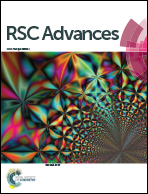Encapsulation of a photosensitizer into cell membrane capsules for photodynamic therapy†
Abstract
Although methylene blue (MB) has promising applications in photodynamic therapy (PDT) with its high quantum yield of singlet oxygen, its clinical application is restricted due to its rapid enzymatic reduction in the biological environment and its relatively high cytotoxicity. Therefore cell membrane capsules (CMCs) derived from mammalian cells were used to encapsulate MB (CMCs@MB) using temporary permeation of the plasma membrane and resealing. The resulting CMCs@MB exhibited a spherical shape with a diameter of about 1 μm. The MB encapsulation, confirmed using UV-Vis spectroscopy, reached a concentration of up to 1.5 mg mL−1 inside the CMCs (1.7 × 106 MB molecules per CMC), which is 7.5 times higher than that of the feeding solution. Encapsulation in the CMCs leads to sustained release of MB and significantly enhances its stability against enzymatic reduction. Furthermore, the CMCs@MB exhibited a much better cytocompatibility under dark conditions than that of free MB at the same concentrations. The viability of cells incubated with the CMCs@MB decreases significantly to a similar extent as free MB at the same concentration after laser irradiation, confirming that encapsulated MB is still efficient for PDT. The protection of MB against enzyme degradation and reduction of its dark toxicity, with retained PDT efficiency, is an important step toward the practical application of MB in cancer therapy.


 Please wait while we load your content...
Please wait while we load your content...